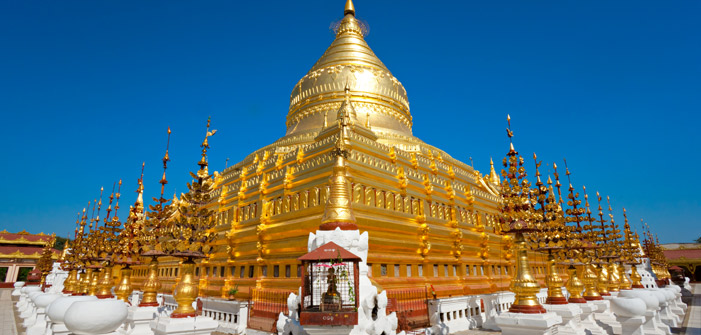Get a slice of history on your visit to landmarks in Myanmar
By Carlton Leisure -
05/11/2014

Myanmar previously called as Burma was inaccessible to the world for a long-time due to military dictatorship but now this country has opened its doors and the travellers who are looking for new destinations are making a beeline to this country where little has changed for more than six decades since its independence. The country seems frozen in time giving an interesting insight into the life during colonial rule. Most of the travellers who want to delve deep into its history and in this pursuit they keep flying to Yangon which is the largest city and jumping off point for many a tour in the country. Here we acquaint travellers with major landmarks in Myanmar.
Mingun Paya
Situated on the outskirts of Mandalay, the town of Mingun is better known for Mingun Paya, also referred as Mingun Pahtodawgyi and Mingun Pagoda. This huge pagoda is situated on the west bank of the Ayeyarwady River. The pagoda was built by King Bodawpaya in 1790 using slaves and prisoners as workers. But pagoda was not completed and now historians give various reasons for its non completion. According to one version an astrologers warned that completion of pagoda would lead to death of the king.
Shwedagon Pagoda
Situated in the heart of Yangon, Shwedagon Pagoda is the most important landmark in Yangon dominating city’s skyline. Sitting atop Singuttara Hill this diamond, ruby and sapphire structure catches attention with its 320 feet structure. This most sacred Buddhist pagoda in Myanmar was build some 2,500 years ago and commands great religious and archaeological significance.
Mandalay Royal Palace
Myanmar has a bevy of historical landmarks but nothing can beat the charm of Mandalay Royal Palace which is situated on the banks of Irrawaddy River. A large part of the palace was destroyed during the World War II, but the palace walls, city gates, pagodas, golden Buddha statues and two enormous lion statues are still intact attracting a large number of visitors. Recently a cultural museum and a floating restaurant have been added to increase its appeal among the visitors.
Bagan
Bagan holds the glory of housing the capital of the first Myanmar Empire. The city founded in 11th century was home to more than 13,000 temples but now the number of temples has been reduced to slightly more than 2,000 and another 2,000 temples are in dilapidated condition. These ruins are situated over an area of around 26-square miles. The town of Bagan is famous for archaeological sites and a pilgrimage center.
Mrauk U
Once the capital of the Rhakine Kingdom; the city of Mrauk U was built during the 15th century. The old part of the city has a large number of moats, artificial lakes and canals and several pagodas. The city is home to several temples that include "Temple of 80,000 Buddhas". Apart from this Mrauk U houses more than100 pagodas.